What Is a Roadmap? The Ultimate Guide for Roadmapping Updated for 2022

What do 20.000 pairs of socks, 15.000 euros, three wasted months, and a weasel wearing a sombrero have in common?
Well, the first three are the story of my failed eCommerce store.
The weasel is there just to lighten the mood a bit and stop making me cry.
Look at that little thing; Senior Weasel almost makes me forget I'm broke.

It was early 2016, I was fresh out of business school, and I desperately wanted to start my own business.
eCommerce was booming, so after way too many inspirational videos, Shopify tutorials, and market research, I decided to start a shop selling custom socks.
I know it sounds stupid, but at that time, the custom apparel and accessories market was red hot.
While the idea was good (or at least I'm trying to convince myself that it was good), my execution was poor.
In a matter of three months, I managed to waste close to 15.000 euros on an unnecessarily large inventory, tons of media gear, slick web design, and branding.
Scope creep got to me.
I couldn't sell stuff without the actual products, so I bought way too much to get a discount.
I couldn't promote them on social media without a good camera, so I purchased a camera that was way too expensive.
And I also thought I'm building the next Zara, so I invested way too much in custom branding and web design.
By the end of the three months, I had zero money for advertising, and my morale was down.
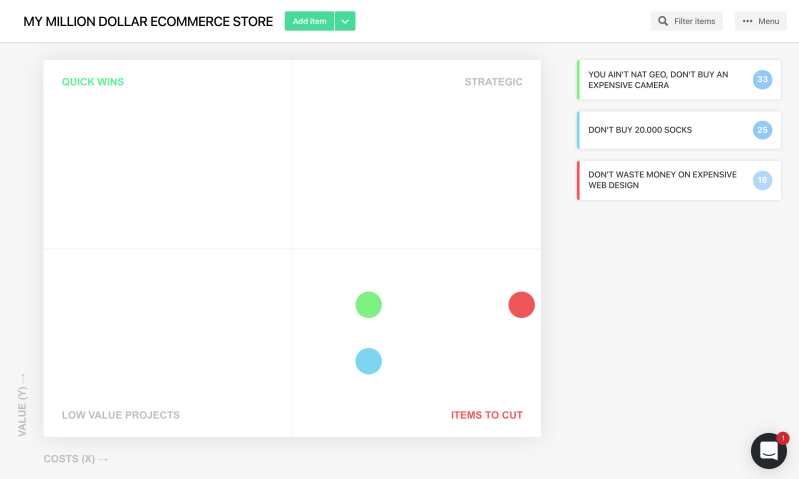
A simple roadmap with my goals, mission, and business plan would’ve been the lighthouse guiding my - now sunk - ship.
Which is a good segway into our topic today.
In this guide, we’ll walk you through the fundamentals of roadmapping, including:
Let’s dive in!
What is a Roadmap?

A roadmap is a high-level overview of a product or project’s vision and direction over time. The roadmap shows the overall strategy and work required to get there.
It serves several purposes:
It maps out your vision and strategic goals, presented in a visual way
Details how you’ll deliver against that vision and strategy
Communicates the necessary information to align stakeholders
Sets your priorities so that you focus on what’s important
Why are roadmaps so important?
Roadmaps prevent situations like our sad eCommerce story by setting a long-term plan, based on strategic thinking and clear prioritization.

1. Roadmaps align stakeholders
A roadmap should be a visible document that everyone in your team can review and agree on. This enables everyone to understand how their day-to-day work fits into the strategic big-picture, helping keep people on track and motivated.
2. Roadmaps highlight priorities and help you execute your strategy
Everybody has something to say about when and how things should get done. But when priorities have been set, a roadmap will help you visualize them clearly. With a shared understanding of strategy, sticking to your roadmap is the clearest way to success.
Types of Roadmaps
When most people think of roadmaps, they think of the product roadmap used by software companies worldwide, from small agencies to global giants like Microsoft, Apple, and Facebook.
These roadmaps are popular with development teams because they enable easy collaboration, track progress, and visualize product strategy.
Yet, these benefits don't just apply to the software.
They apply to all teams, including sales, marketing, HR, and operations, with just a few small adaptations to suit the use case.
Before you build a roadmap, it’s therefore really important to be clear on who will be using it and what the focus should be.
Here are some examples of different types of roadmaps:
Product Roadmaps
A product roadmap is a visual document that serves as a single source of truth to map out both the short and long-term direction of your product, as well as all the steps that need to take place to deliver against your goals.
Depending on your use case or audience, you may decide to opt for a:
Progress-based roadmap: A progress-based product roadmap divides the current items into lanes based on the level of progress, for example, as "to-do," "in progress," or "done."
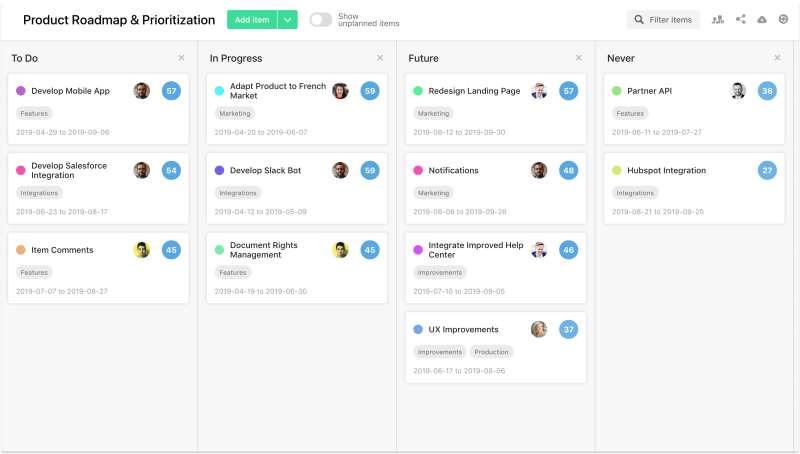
They are commonly used in agile development, one of the reasons being that they generally offer users more flexibility than time-based roadmap as, instead of being restricted by dates and deadlines, tasks are based on progress.
Time-based roadmap: These types of roadmaps are primarily focused on dates, milestones, and deadlines.
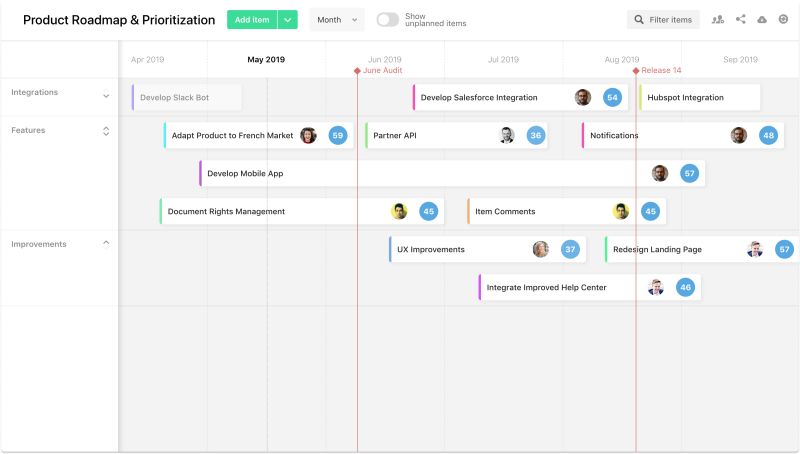
They use time as the main mechanism for measuring success, which can be a great method for visualizing how your product will progress over time.
Unfortunately, time-based roadmaps can sometimes be too restrictive for a more dynamic business environment that requires a more flexible roadmap.
Of course, there are also mixed roadmaps. Where you have fuzzy time roadmaps where kanban board columns represent a rough timing estimation, like "Future," "Soon." "Next," "Maybe” and “In progress.”
When building a product roadmap, consider the following tips:
Stress to stakeholders that the roadmap will change and that flexibility is an essential part of the agile process. Ideally, you should make sure to involve them in the prioritization process from the early stage of the project, so your vision aligns.
When using a time-based roadmap, make sure your time scale isn't too specific or detailed, particularly if you have planned far ahead.
Don't create "fake precision." For example, it's impossible to predict that your Intercom Integration will be done by a specific Friday, 13 months from now.
Business Roadmap
Traditionally, businesses communicated their strategic thinking in long business plans. These important documents were often never seen by anyone outside of the management team.
This, inevitably, led to confusion and frustration, as departments lost sight of where they fit into the bigger picture.
However, business roadmaps offer a better way.
Business roadmaps allow cross-organization teams to plan and communicate strategic goals while keeping stakeholders aligned.
Business roadmaps also tend to be high-level documents focused on the key steps required to achieve the business's key objectives and goals.
This applies across all teams, giving whole organizations a visual overview of how their work is contributing to the strategic direction of travel.

How a business roadmap looks will depend on your use case:
For a new business, a roadmap is a visual summary of what needs to be done next and due, to limited capacity, likely in sequence.
For a growing business, it helps prioritize tasks with limited resources available and helps team members multitask to better achieve organizational goals.
For a larger company with HR, marketing, sales, and product to manage, a business roadmap can have separate roadmaps for each department and optionally roll all of them into one master roadmap.
Depending on your use case, you may decide to opt for a:
Progress-based roadmap: to get all teams on the same page about their tasks progress and overall task status.
Time-based roadmap: to visualize on a timeline what got done over a period of time and what’s coming next.
Technology Roadmaps
The amount of technology required to run a modern business is overwhelming and constantly changing.
Technology roadmaps are used to plan the complicated process of implementing new tools in the workplace and who will be responsible for ensuring the success of the project. It can also be used for change management, upgrades to tools, or rolling out changes to a whole organization.
For example, if you’re switching software systems, you could use a technology roadmap.
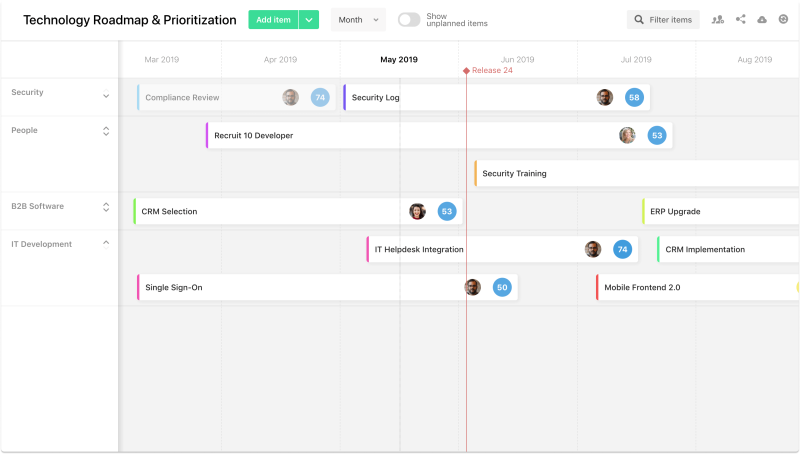
Data will need to be migrated and employees retrained, without impacting customer service or revenue. A technology roadmap breaks this up into steps to be completed over time and keeps everyone on track.
A technology roadmap is, therefore, a powerful tool to avoid costly mistakes, plan ahead for all possible scenarios, and help your department understand the implications of any IT infrastructure changes made.
Marketing Roadmaps
A marketing roadmap provides a high-level overview of your marketing strategy for your team and stakeholders.

In many cases marketing roadmaps illustrate projects and activities from various channels like digital marketing, content, events, guerrilla marketing campaigns, and advertising.
Marketing roadmaps show what the marketing team is working on at a glance. T
his must be easy to understand, as marketing teams are often project-led with several deliverables and projects being worked on at once.
For example, think about running the marketing team at Apple. When the iPhone is announced, simultaneous projects must launch, including digital, social media, and TV advertising.
Having a roadmap enables the team to see the big picture and plan the resources required to ensure a successful launch.
Building Your First Roadmap
Ok, so by now you should have a fairly clear idea of what a roadmap is and how roadmaps can be applied to different business contexts to map our vision and strategic direction.
But, how do you go about building your first roadmap from scratch?
Here are the three steps to build an awesome roadmap.
1. Determine/define your use case.
What are you trying to plan and visualize with this roadmap?
The use case has a lot of implications on the structure of the roadmap and what information it should include.
Is it for a specific product launch or should it show how your complete product portfolio develops over time?
The difference is that in the first case you will need to define a short time horizon, work on only one product, and you will have specific timings/deadlines that are important. While in the second example you will deal with several products, a long time horizon, and specific timings not important eliminating fake precision.
2. Define the audience
Everyone involved has input on the structure and included information too. For example, C-level mostly needs at least a rough timing schedule.
The same goes for the marketing team, as they need to align their marketing campaigns. Or, when you share this roadmap with customers, you shouldn’t show exact time estimations, to avoid promises you can not deliver.
If it's only for your product and dev team, you might consider avoiding timing at all and go with a progress-based roadmap. Usually, the development team mostly needs more details than C-level people, which would like to have a quick overview. Rule of thumb: Include as little information as needed, to avoid confusing people and starting unnecessary discussions. This does not mean, you need to build several roadmaps for every audience.
A good roadmap tool allows you to build different views and filter sets, so you can create a specific roadmaps view for every audience in minutes.
3. Prioritize what items should make it to your roadmap.
Once the structure is set you can now start prioritizing what projects, initiatives, epics, or features should make it to your roadmap. You shouldn’t bite more than you can chew.
We believe that a roadmap without prioritization is useless. Your projects should go through a thorough prioritization process before they make it to the roadmap. A good roadmap tool should make that prioritization accessible to you, your team, and your stakeholders.
Roadmap Templates
To save you the time and headache of building a roadmap from scratch, we've put together a wide range of roadmap templates for every industry and use case.

You can fully customize these to suit your unique roadmapping requirements, editing the built-in prioritization feature to your unique criteria.
Product Roadmap Templates
This product roadmap template enables product teams to communicate their high-level strategy and goals. It also includes a ready-to-use prioritization framework, which you can easily modify to match your goals.
We've also put together a few specific templates you'll find helpful:
For scrum devotees, try our sprint roadmap template.
For software development teams, try this software roadmap template.
Manage multiple products? You need a portfolio roadmap template.
Getting ready for launch? Get marketing and product on the same team with our product launch template.
Technology Roadmap Template
Whether you plan on adopting a new technology stack, adding a new technical feature, or working on a new IT project, starting with a blank roadmap can be intimidating.
This template shows short-term and long-term concerns and helps you make objective decisions with a multi-dimensional prioritization matrix, based on technical requirements and development costs.
If you are an IT team working and you’re working on a technology project, you’ll find our technology roadmap and prioritization template useful.
If you are responsible for several products consider using our program roadmap template.
Marketing and Business Templates
Marketers and decision-makers need not be envious of their product development colleagues, you can use roadmaps to communicate too.
For marketing teams, calculate the impact of your work with this marketing planning template. Simply change the value criteria from brand awareness to whatever KPI you are tracking.
Business owner, strategist, consultant, or executive? Get everyone on the same page instantly with our business project roadmap template. Justify your decisions and spend with the built-in prioritization matrix.
Startup? Build a Unicorn by bringing order to chaos with this startup roadmap template. It'll tell you in seconds what you should be working on next.
Now you’ve got the skeleton of your roadmap together, it’s time to bring it to life. Next up: prioritization...
How to prioritize a roadmap
Roadmaps are an excellent tool to visualize your high-level strategy, but — even with the best template and planning in the world — no team has unlimited resources.
To help you decide which projects or initiatives make it to the roadmap, you need to prioritize carefully.
This will make sure you can get the most out of limited resources by allocating them to tasks that have the highest impact.
There are a million different ways to prioritize a roadmap, but a quantitative and time-efficient way is by using a simple "prioritization matrix" or "weighted scoring model". This is a proven framework that will help to identify risks and ensure the success of your roadmap.
We include ready-to-use prioritization frameworks within all of our templates, so you don’t need to invent your own These frameworks are used by thousands of companies and decision-makers like Nike, Shell, and The Washington Post. Check them out here. If you prefer to do this manually, here’s a rundown of how to prioritize a roadmap in 4 simple steps:
1. List your choices
Write down all the possible items of work that your team could kickstart right now. For example, for software this could be:
New features
Projects
Initiatives
2. Determine criteria
The next step is to figure out what key criteria you’ll use to make decisions. Positive criteria often represent your current business goals like customer value, revenue increase, or strategic fit. Make these factors columns.
For example, you could have customer value, costs, and risks as your criteria.
Optionally, assign each of these criteria a weight, signifying how important those criteria are to your project.
For example, in this example we’re focused on customer value, so we would weigh options as below:
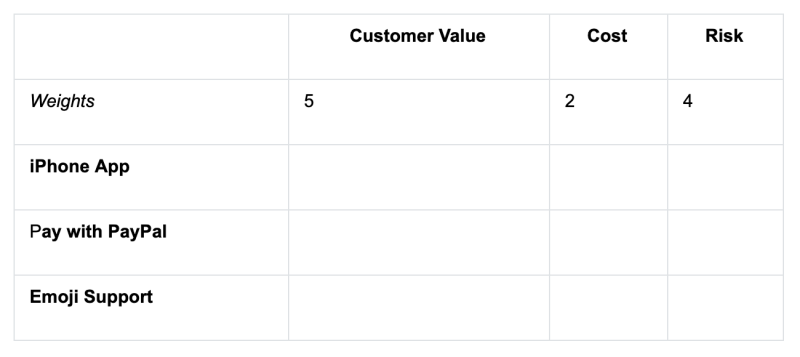
3. Scoring
On a scale from 1-5, rate each of the rows in each of the columns. You should ensure a 5 represents a more preferable option for them all. For example, a lower-cost option would score 5.
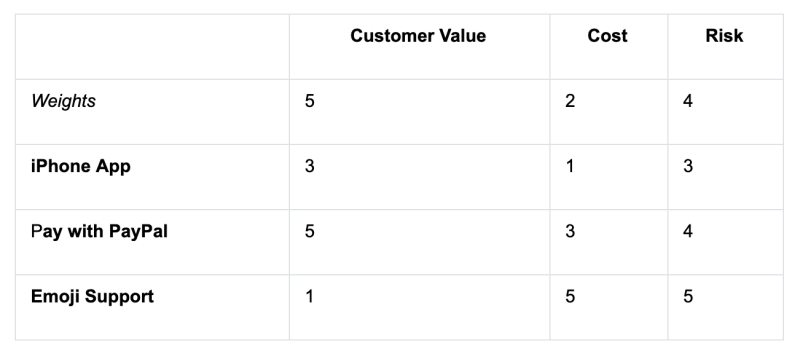
4. Calculate your weighted score
Multiply your scores by their weight. The highest total scoring rows are the ones you should prioritize.
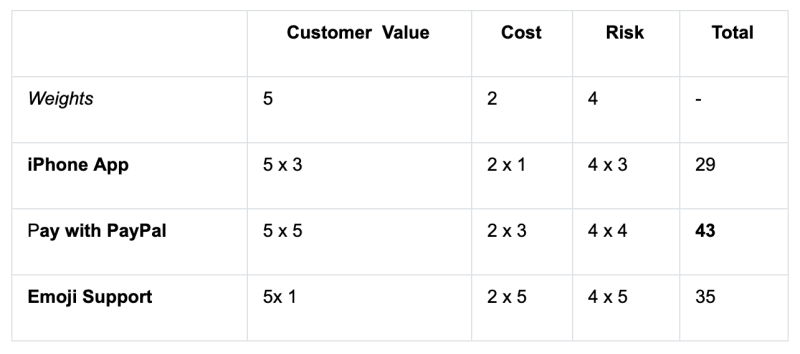
Now you understand how to use this matrix, you'll be able to plan and explain your prioritization decisions to stakeholders or decline feature requests.
Download now: Get our 5-minute guide on How To Use Weighted Scoring
To save time, try using the airfocus built-in scoring feature and prioritization tool, which does all the calculation work for you.
How to use Priority Poker to make better prioritization decisions
One disadvantage of the prioritization process is that it does not work well in bigger groups. Your biases and preferences will (no matter how hard you try) shift the weighing in your favor. Even if you sit with colleagues and prioritize collaboratively, some bias will affect the decisions you make.
One common mistake when prioritizing collaboratively is to allow the HiPPO (Highest Paid Person's Opinion) too much influence in decisions.
Sometimes, the impact of a HiPPO can be subtle ��— an off-the-cuff comment can be interpreted by others as order and change the entire direction of a product.
A classic example of this is when a CEO casually asks for an estimate of how long a feature will take to build.
A developer quickly gives a ballpark figure, being keen to please. Due to the influence of the CEO, this ballpark unintentionally becomes a commitment that affects the entire roadmap.
Worse, a stubborn HiPPO can actively derail your roadmap with their influence. As a product professional, you need a method that enables all stakeholders to be heard, so your roadmap can be realistic and achievable.
This is an awesome solution for priority democratization.
airfocus has designed an effective and fun solution to this age-old problem. It’s called Priority Poker.
Priority Poker is a revolutionary new way to play your way to better, more objective decision-making.
Simply choose the items you need to prioritize, invite stakeholders to rate each item via their smartphone, and hey-presto! airfocus will analyze your results to deliver your final unbiased set of prioritized tasks based on shared team wisdom.
The importance of using the right roadmapping tool
So, now you know why roadmaps are important and how to create one. But are you using the right tools for the job?
As product managers ourselves, we often see tools like Spreadsheets (Excel) or presentation software (Powerpoint) to build their roadmaps.
We've seen hundreds of people spending hours every week to build and update their roadmaps using these tools.
Then they send these documents via email to their stakeholders. Once the stakeholders found them in their crowded email inbox, they don't know whether these roadmaps are still up to date.
But as we have discussed throughout this article, there is one key element that underpins each and every roadmap that these tools simply cannot facilitate: strategy.
That’s why it’s so important to make sure that you embark on your roadmapping process with the right purpose-built tool.

With a dedicated roadmap tool you can:
Build roadmaps easily
Your job is hard enough. A roadmap tool should make your life easier so you have more time to manage your projects.
Change and update tasks in only a few minutes
A roadmap is a living document. They evolve constantly as priorities change. You need to be able to update instantly and not spend hours updating the roadmap before a meeting with your executives.
Visually Compelling: A roadmap illustrates the future of your company, product, or project. It should be inspiring and encourage discussions.
Share plans that are always up to date: Your audience needs an up-to-date roadmap, and not have an old version stuck in an inbox somewhere.
Build different versions for different audiences: Create several views as your audiences need different information
Strategically Helpful: The best roadmapping tools include prioritization tools. The tool helps you think to remove bias from your decision-making, so that you can the most effective route toward your shared company vision.
How to make a roadmap with airfocus
Creating a prioritization roadmap is simple with airfocus.
Start by selecting one of our roadmap templates. We offer pre-built templates that are fully adjustable and built on proven decision-making and roadmapping methods. All our templates are fully customizable. Adapt them to your needs if required. You can do that right in the beginning or later on.
Add your Projects, features, and initiatives manually or import them from your existing tools.
Airfocus integrates Jira, Trello, Asana, or CSV as well as 1000+ other tools via Zapier. Here, you can set factor scores and customize the look of the work items, changing things like colors and labels.
Prioritize your roadmaps and map your priorities on a chart to better understand what projects are most important.
Share your roadmap in minutes through a share link, so everyone is aligned with your strategy. Define precisely, what information your audience should see.
Your roadmap is constantly changing and so will the shared version of it so everyone is in the loop.
You can display dependencies if items on a roadmap block each other.
TL;DR Your Roadmap Summary
If you scrolled right to the bottom of the article without reading, here’s the TL;DR of roadmaps:
A roadmap is a living document that conveys the strategic direction for your product.
Roadmaps can be used for marketing, software development, business and IT projects to align everyone with a shared vision and understanding of the progress.
You should prioritize precisely what ideas, initiatives, and projects should make it to your roadmap as resources are limited. The best and most efficient way to build a roadmap is by using a dedicated roadmapping tool. All your information will be stored in one platform that your team and stakeholders have access to easily.
Now, you are ready to make your own roadmaps, but you can use our framework and templates to save time.
We’ve made dozens of interactive and beautiful roadmap templates for every industry and possible project, just edit it to match your needs and claim you made it all by yourself.
Then, when you change the world and get that epic promotion, let us know (@airfocusApp) so we can celebrate with you!
2022 Update
Why are roadmaps so important in 2022?
By now we’ve learned that roadmaps are flexible, organic documents. They don’t need set dates and they need to adapt to changing conditions.
Businesses operating with rigid strategies and plans were left in turmoil as 2021 went on. Quarterly initiatives? Out the window. Soft and hard launch dates? Totally reconsidered.
Some products were shelved entirely as a result of changing customer behavior and needs.
That’s when a roadmap comes in so useful. It can help you keep on the right strategic path while finding new routes forward. This is truer than ever in 2022, as the world continues to respond to life during a pandemic.
Roadmaps can even encourage you to think problem-first. Rather than jumping ahead and adding solutions to your roadmap, why not take the time to explore the desired outcome first?
We can’t claim to have a crystal ball or any ability to see into the future (if we did, we’d certainly have monetized it by now and be swinging in a hammock on a Caribbean island). But we do know that prioritization is, and will continue to be, one of the most important responsibilities for teams to get right.
When the tide turns unexpectedly and your game-plan gets interrupted, change. What’s the point in staying still and hoping for the best? Use your roadmap to reprioritize and decide the next best move.
2020 and 2021 have been defined by “one step at a time” and that’s exactly what a roadmap is designed to help you achieve.

Andrei Tiburca

Read also






Build great roadmaps

Experience the new way of doing product management




